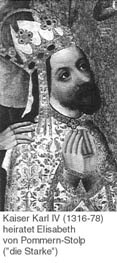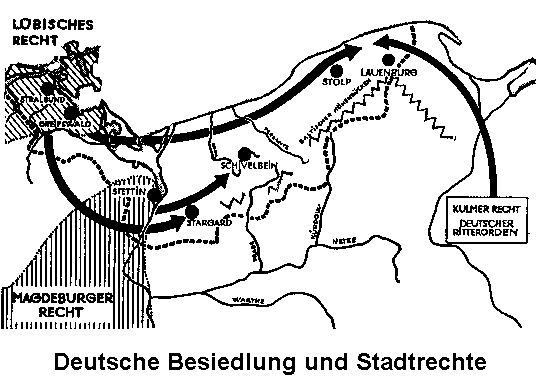
Links
Short History of Pomerania: ContentDiese Seite auf Deutsch: Die deutsche Besiedlung Pommerns
Pomeranian_Griffin: The worldwide Pomeranian Group in Internet

3. The German Settlement of Pomerania (1150-1350)
For Pomerania the 12th century was not only that of a transition to firm state-resembling relations and the era of Christianization, but also one of severe devastations through war and plunder. Entire regions along the river Rega, in the vicinity of Pyritz and the country side of Kolberg, were desolate and deserted. If the Christianization from Germany would not immediately follow the German colonization of the land, it now became an absolute necessity.
The 13th century became the time for the German settlement of Pomerania. The native population of the Slavic people as well as Danes were involved. The driving forces were the rulers of Pomerania and Ruegen, also in small numbers the aristocrats, the mentioned monasteries, charitable institutions as well the religious knight fraternities. The most concern was to settle the devastated area, to make it useable and for owners to collect dues from the settlements.
Around 1200 ended the settlement from the German people, of the west and south Pomeranian borders. But there were some exceptions, because in the area of the Kolbatz monastery, some German farmers were traced back to 1173. A few years later German traders and merchants settled in Stettin. The actual immigration of Germans into Pomerania to started in the 2nd quarter of the 13th century. Two flows groups of people need to be recognized. The first one was along the coast line toward the east, thru Mecklenburg and Vorpommern and the islands of Usedom and Wollin and along the "Hinterpommern" (eastern Pomeranian) coastline. This route was taken by settlers from the Lower Saxony, the area of Westphalia and Holstein. They brought along the "Luebische" laws, the farm house and the "Hagenhufendorf" of the Lower Saxony. A Hagenhufendorf is farmsteads built on a road in a shape of a horse shoe surrounded in a right angle by farm land. The ending of their family names was frequently "-hagen". These settlers who took this direction, settled mainly the principality of Ruegen. Therefore, the contract of Tribsee from November 24th 1221 between the duke Wizlaw I. of Ruegen and the bishop from Schwerin was a very important source. After the settlement of the principality of Ruegen, followed the partial settlement of the Duchy from Wartislaw III and "Hinterpommern" (eastern Pomerania). The second flow of settlers ended in the area of the aristocracy family of Barnim I, it sourced from the foreland of the Harz mountains, the diocese of Magdeburg, the Altmark and Brandenburg. These people preferred "Angerdoerfer", where the houses are arranged around a long drawn village green. In this area Magdeburgian law was valid. The German immigration was carried out peacefully and covered all sections of the population: merchants and artisans (craftsmen) for towns farmsteads and aristocrats.
Already in Slavic times you find trade centers (vicus, Wiek). The most important one was Ralswiek on the island of Ruegen. German cities had their own legal system, with their own jurisdiction and administration. They had administrative and trade centers, respectively economy centers for the plains and surrounding area. Most of them were developed next to the Slavic settlements, and they followed west and east on the trade route from Luebeck to Danzig. Or on the trade routes from Neumark to Poland. The Principality of Ruegen was first in establishing its own sovereignity of towns: Stralsund (1234), Tribsees (circa 1245, at the latest 1267), Barth (1255), Damgarten (1258), Rügenwalde (1271). The dukes of Ruegen reached with some of their Principalities , far to east,- Grimmen (circa 1287), Richtenberg (between 1297 and 1351), and Garz (1319) as the continuation of the 1313 by founded Ruyendal. In the Duchy of Pomerania was the already mentioned Barnim I (1218/1219- 1278) of Pomerania-Stettin respectively of the whole Pomerania (since 1264) the most important founder of cities. 1234 granted Barnim I privileges to Prenzlau, and around the same time was in the area of Templer the city of Bahn founded. Stettin received at that time the German municipal laws, by that was meant the law of Magdeburg (1243). Then followed in the year 1240 Pyritz, Gartz an der Oder (circa 1249), Altdamm (1249/1260), Pasewalk (circa 1250), Anklam (before 1264), Fiddichow, Greifenhagen (1254), Ueckermünde, Poelitz (1260), Stargard (1243 or 1253), Gollnow (1268), 1277 followed Treptow an der Rega. Barnim I together with his cousin Wartislaw III founded Wolgast (before 1259) Wartislaw III founded Treptow an der Tollensse (Altentreptow 1245?), Demmin (circa 1249), Greifswald (1250), Wollin (before 1264) and Greifenberg (1262). Usedom was in the direct neighborhood of the Slavic trade center, only receiving the German law in the year 1298. Fifty-four towns in the west and middle Pomerania had German laws, 44 of these towns were established between 1234 -1280; 21 of these towns were established by Barnim I. As before indicated, the coastal region had the "Luebische" law, the inland had the Magdeburger law, which was then developed to the Stettin municipal law. Stettin became the regional jurisdictional office of all the towns ("seines Rechts") with its justice. Also, in the 13th century numerous institutions and monasteries were founded. Neuenkamp became an institution (1231). Barnim I. himself created the Zinsterzienserinnen monastery in Stettin (before 1243) and Marienfliess (1248), the Chorherrenstift (institution) Ueckermünde (1260, since 1331 in Jasenitz), the Marienstift (institution) in Stettin (1261) the Augustiner- Eremiten monastery in Stargard (circa 1270). Contrary to the establishment of monasteries in the 12th century, this foundations played a very imported role in the colonization of Pomerania.
The settlement and development of Pomerania went hand in hand. Individual settlers, entrepreneurs (Lokatoren) and agents directed the local settlers and farmers. Some of the developing villages were named after the Lokators, they then usually held also the office of the magistrate (mayor) and there for being in charge of the jurisdiction. The enterprises of the German farmer, who were all free, had to pay only very small fees for deliveries. This was different from the Slavic neighbors. They were much more productive and therefore because of their taxes much more interesting for the rulers of the country. The boundaries of the villages were surveyed land. The land was then divided into Hufen (Pomeranian measures of land). A Hufe had on an approximately 17- 24 hectares or 68-96 Prussian Morgens. A farmer usually farmed 2 Hufen. This happened in a form of a "Dreifelderwirtschaft" (three field cultivation), this was practiced till 1812 in Pomerania. This was all new to to the Slavic inhabitants, including the "Flurzwang". By this economy form the village fields were divided into three even fields for summer harvest, winter harvest and one for fallow land ("Brache"). This way each farmer owned a third of each kind of land. The new settlers used for cultivation of the fields, the metallic "Scharpflug" plow, which was technical superior to the Slavic hook. Villages developed in cleared areas or beside Slavic settlements. The Slavic villages differed in the name, by adding the word "Klein" (little) or "Wendisch" to the village name. The German settlements along the coast line in the Principality of Ruegen were " Hagenhufendoerfer" in the inland, the majority however were "Angerdoerfer" (meadow villages).
Along with the farmers, craftsmen and merchants, also German aristocrats in leading positions came to Pomerania. Usually from the originally no free ministerial positions. In late first half of the 13th century, the dukes of Pomerania attracted more German aristocrats and knights. They received a lien on some property and settled farmers. The same way the aristocrats possessed the governed right over villages, part of villages and estates. Therefore the inhabitants of this places were obligated to pay a relatively small amount of money and and services to the masters. In the first years the settlers usually had to pay nothing. The domestic Slavic aristocrats got out of this areas to the regions east of the Oder river, and some times even further east, where the Germans diminished their settlement. The German aristocrats got land and castles from the rulers, and from that time on they started the Vogtei (bailiwick) law. That meant smaller jurisdiction and tax collection for the ruler.. The families von Behr, Salzwedel, Schwerin, Rohr, Ramm, Putbus, Lancken und Platen had control west of the Oder river in the island of Rügen. The families von Below, Borcke, Eberstein, Natzmer, Dewitz, Kameke, Puttkammer respectively their ancestors Massow, Mitzlaff and Zitzewitz, east of the Oder river and in the south the families von Osten, Flemming, Wedel, Kleist, Manteuffel, Podewils, Lettow and Bonin this are only a few names mentioned. This are the names which can't be excluded from the history of Pomerania. Some of these families are from Slavic origins, and in the east of Pomerania, where the Slavic aristocracy evaded, Slavic families mixed itself with German newcomers. Pomerania became, especially in the eastern parts, a territory, determined by German aristocracy. Nevertheless Pomerania was from the end of the middle ages respectively to the beginning of the time of reformation , farmland with small and middle sized farms. Even the estates from the noble families were only a little larger as the more important farms. These fundamentally and slowly changed with the beginning of modern times.
At the beginning of the German settlements, the Germans and Slavic lived separately in the neighbor hood, some times it was very close, but never less apart. Gradually both population groups and the noble families mixed with each other. It became a German determined new tribe of Pomeranians This process ended in the middle of the 14th century, when the German settlement movement in Pomerania became to a certain end, being regarded only about two centuries later completely finished.
Next Chapter: 4. From the
Middle of the 13th Century to the Death of Bogislaw X (1250-1523)